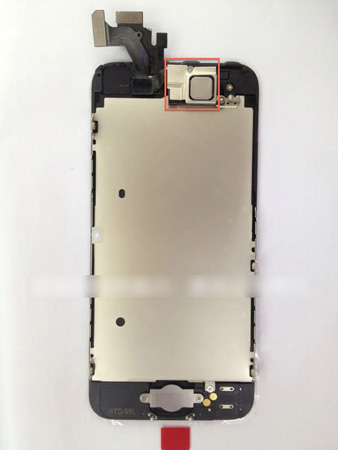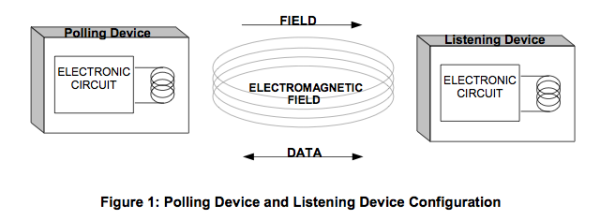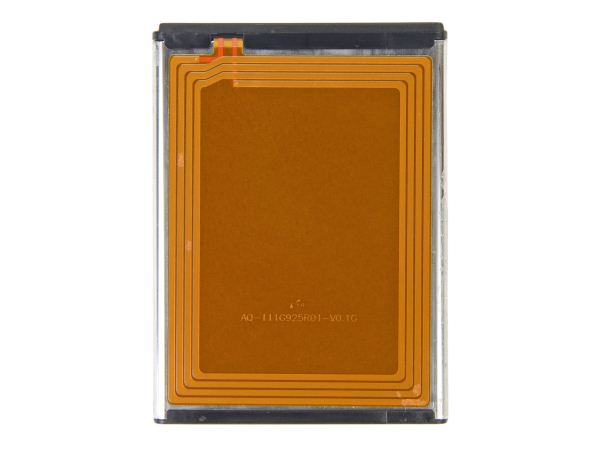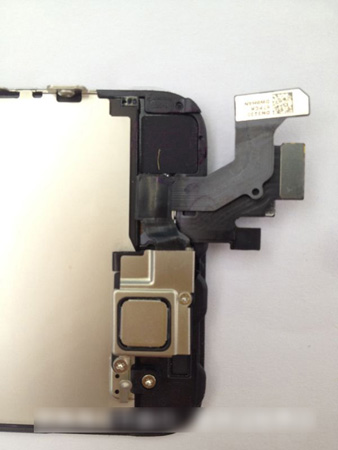Preparing for the iPhone Next: Rumors Analyzed
by Brian Klug & Anand Lal Shimpi on August 27, 2012 9:40 PM EST- Posted in
- Smartphones
- Apple
- Mobile
- iPhone
NFC, Unlikely
The most recent rumor is that this mysterious square chip (occluded by an EMI can) is an NFC combo controller and antenna, based purely on its square dimensions.

The NFC "chip" ensquared in red
Given the primarily metal backside of the new iPhone, it's highly unlikely that NFC is in the cards for this generation. In fact, given the very little space at top and bottom dedicated to those glass RF windows, you can almost entirely rule it out.
NFC operates on the 13.56MHz ISM band, which has a relatively large wavelength, at 22.1 m. Making a traditional dipole antenna that radiates at all given the constraints of a smartphone package is thus a big challenge, considering that smartphones are maybe 5-inches tall at maximum, to say nothing of the supposed upcoming iPhone's longest linear dimension.

From the NFC Forum Analog Specification
As a result almost all NFC antennas are big inductors and work using a magnetic field coupled between a host and peer device. Since we're talking about an inductor, NFC antennas use as big of a coil of wire as possible with as many wires as possible tightly wound together, and thus often use as big of an unbroken 2D plane as they can get on the device. In the smartphone space, basically all NFC antennas to date are simply flat spirals on a PCB. Whether this gets hidden on top of the battery like what Samsung has done in recent devices, or printed on the back battery cover like earlier devices, the antenna is ultimately a big square or circle with as big and dense of a coil as possible.

Galaxy Nexus Battery and NFC Antenna Coils (Courtesy iFixit)
Getting a good inductor into the device is important because how much inductance your antenna has will determine maximum coupling distance and ease of alignment. It shouldn't need saying, but having a huge ground plane (the unibody metal back case) in the way of your NFC antenna will seriously degrade performance, thus only the top or bottom windows are logical places to put it.
It's this last point which makes us very skeptical about the top or bottom RF windows being used for a relatively small NFC loop – not because such a thing is impossible – but rather because of how terrible the resulting ease of alignment and maximum coupling distance would be. Most NFC implementations at present place the inductive coils as near to the center of the device as possible, partly because this is the most optimal way to maximize the area which can be dedicated to it, partly because it makes alignment natural. With an NFC antenna at the extreme top or bottom, alignment with non-iPhones (for example, payment tokens or reader tags) becomes a much more confusing task, and that doesn't seem like the Apple-like level of polish everyone is waiting for to drive NFC adoption.

There's also a healthy number of signaling pins in the flex cable leaving the mystery chip, some of which appear to be signaling for the front facing camera which is part of the assembly, others for earpiece, proximity, and ambient light sensor. In addition this assembly also is obviously the assembled display and touch stack. When you consider the inclusion of in-cell touch sensing which has been rumored for the upcoming iPhone, and the requirement for time multiplexing of both display driving and touch sensing signals (to mitigate interference and make this possible), it's more likely that the components under that heavily shielded (and grounded with a big spring finger) EMI can are the touch and display controller combo that need to work in conjunction for in-cell to be possible.
The inclusion of Passbook in iOS 6 is the most often-cited piece of evidence for Apple including NFC, which seems a bit paradoxical since Apple hasn't disclosed at all whether it would favor NFC or a Bluetooth LE (low-energy) or even QR code based payment token through that gateway.










131 Comments
View All Comments
Super56K - Friday, August 31, 2012 - link
It's troubling that you pull the seniority card while sounding like a teenager with all the iSlander and hyperbole. I understand having dislike for company or brand X, but this is honestly the best way you have to voice that?Focher - Tuesday, August 28, 2012 - link
If you had any dedication to your principles, you would be wandering the streets and castigating people whom you see with Apple products. if you choose to do this, I suggest focusing on any nearby bus or subway so you don't stand out.versesuvius - Wednesday, August 29, 2012 - link
Not getting hit by an iSh.. will do just fine.Actually a good advice for iSh.. consumers, though.
cjs150 - Tuesday, August 28, 2012 - link
Beautiful design, great OS has everything a smart phone should have, and best battery life but...Why is it still rubbish at the basis function all phones should do - make and receive phone calls.
In my office we run a mixture of phones some old style bricks, iPhones and Samsungs Galaxy IIs.
The iPhone is by some distance the most flaky at phone calls, too many drop outs, voices fading out for no apparent reason. Even some friends who work very closely with Apple agree, if viewed purely as a phone with no "smarts", it is significantly weaker than 5 year old bricks from Nokia
iwod - Tuesday, August 28, 2012 - link
Sure that is not some thing to do with carrier rather then phone?cjs150 - Tuesday, August 28, 2012 - link
At work we are all on the same carrier.The iPhone is simply not good enough at phone calls. It is fine with a strong signal and you do not move around, but if walking and signal fades then iPhone will drop the call faster than any other phone we use, or just go silent
ajp_anton - Tuesday, August 28, 2012 - link
With a larger device allowing a physically larger battery, why does its capacity increase by such a meaningless amount?A5 - Tuesday, August 28, 2012 - link
I think it is thinner, so the overall volume isn't that different despite being larger in L and W.yankeeDDL - Tuesday, August 28, 2012 - link
I am not really sure what I expected, but is anyone else disappointed as I am?I am not an aApple user, and I will likely not become one after the iPhone5 is released, but I am interested in the trends, especially on the phones that are expected to set the standards.
The larger screen is a welcomed addition: for me 4" is the minimum in a smartphone, so I am glad that the iPhone caught up.
But no NFC? I am looking forward to NFC taking place and stop bringing my wallet around .. this won't hapen until all the mainstream phones will support it, so that's disappointing.
The phone also doesn't seem to have anything revolutionary ... which is probably the intention. Still, I was hoping to see the screen size take up nearly all the area of the phone, while it doesn't.
And what's with yet another proprietary connector? Why not USB + headphones, like every other normal phone?
I thought that the EU passed a regulation that every phone should have a standard charger. I guess I was wrong.
And what about making it easier to have an extra battery at the expense of slickness? My first mobile phone, 20 years ago, had 2 types of back cover: a thin/ligt and a thick/long-lasting. Can't compare really, but that phone lasted 2 weeks on a full charge with medium use (only a "phone" of course).
Mah!
MatthiasP - Tuesday, August 28, 2012 - link
For you 4" are the minimum, for me it's pretty much the maximum for a device i have to carry around. I'm glad there is atleast one highend phone that isn't so ridiculously big.